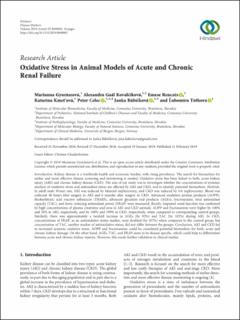| dc.description.abstract | Introduction. Kidney disease is a worldwide health and economic burden, with rising prevalence. The search for biomarkers for earlier and more effective disease screening and monitoring is needed. Oxidative stress has been linked to both, acute kidney injury (AKI) and chronic kidney disease (CKD). The aim of our study was to investigate whether the concentrations of systemic markers of oxidative stress and antioxidant status are affected by AKI and CKD, and to identify potential biomarkers. Methods. In adult male Wistar rats, AKI was induced by bilateral nephrectomy, and CKD was induced by 5/6 nephrectomy. Blood was collected 48 hours after surgery in AKI and 6 months after surgery in CKD. Advanced oxidation protein products (AOPP), thiobarbituric acid reactive substances (TBARS), advanced glycation end products (AGEs), fructosamine, total antioxidant capacity (TAC), and ferric reducing antioxidant power (FRAP) were measured. Results. Impaired renal function was confirmed by high concentrations of plasma creatinine and urea in AKI and CKD animals. AOPP and fructosamine were higher by 100% and 54% in AKI, respectively, and by 100% and 199% in CKD, respectively, when compared to corresponding control groups. Similarly, there was approximately a twofold increase in AGEs (by 92%) and TAC (by 102%) during AKI. In CKD, concentrations of FRAP, as an antioxidative status marker, were doubled (by 107%) when compared to the control group, but concentration of TAC, another marker of antioxidative status, did not differ between the groups. Conclusions. AKI and CKD led to increased systemic oxidative stress. AOPP and fructosamine could be considered potential biomarkers for both, acute and chronic kidney damage. On the other hand, AGEs, TAC, and FRAP seem to be disease specific, which could help to differentiate between acute and chronic kidney injuries. However, this needs further validation in clinical studies. | en_US |

